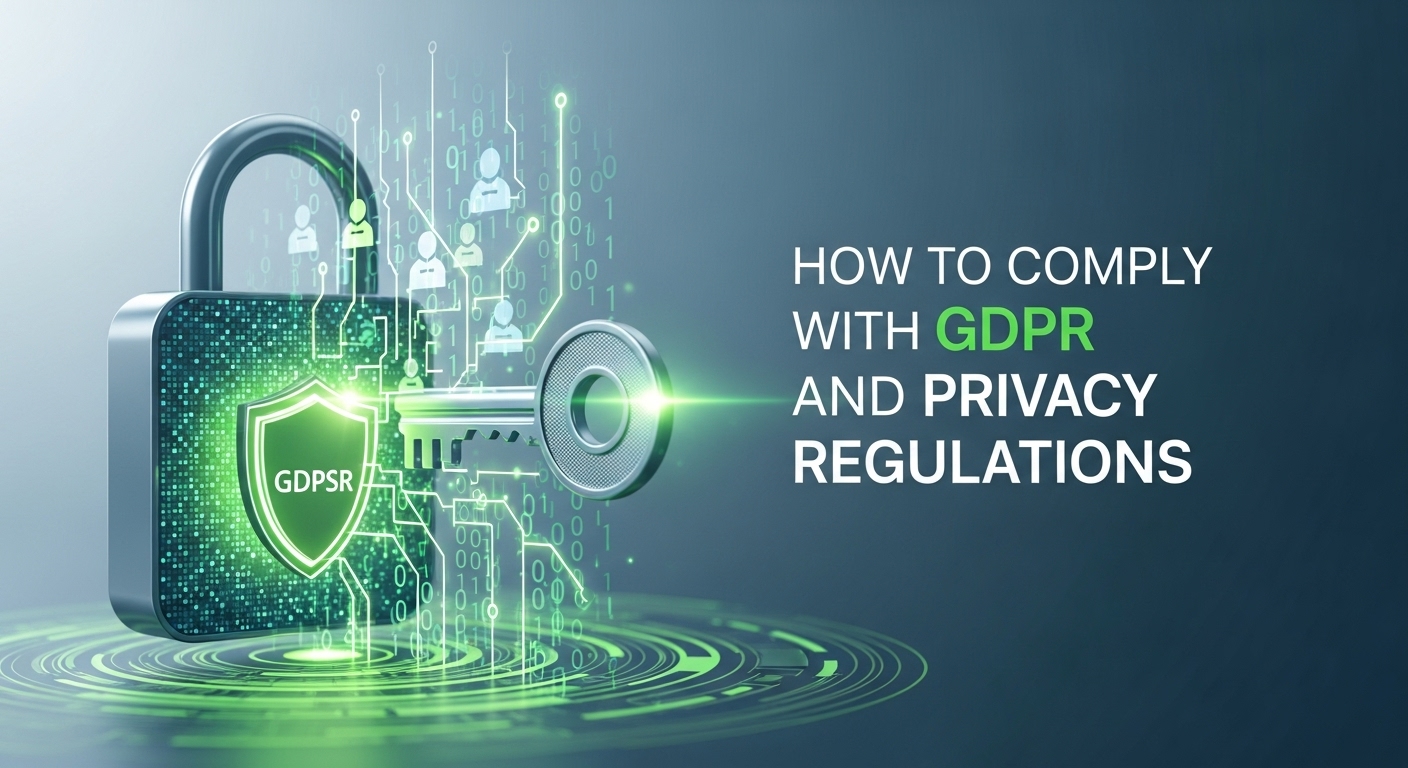GDPR compliance has become a critical business imperative since the European Union’s General Data Protection Regulation took effect in 2018. With penalties reaching up to 4% of annual global turnover or €20 million (whichever is higher), organizations worldwide cannot afford to ignore these privacy regulations. Whether you’re a small startup or a multinational corporation, understanding and implementing proper data protection measures is essential for sustainable business operations.
The landscape of privacy regulations extends far beyond GDPR, encompassing frameworks like the California Consumer Privacy Act (CCPA), Brazil’s Lei Geral de Proteção de Dados (LGPD), and numerous other regional requirements. This comprehensive guide will walk you through the fundamental principles of GDPR compliance and provide actionable strategies for navigating the complex world of privacy regulations.
Understanding the Foundation of GDPR Compliance
GDPR compliance begins with understanding six core principles that govern all data processing activities:
- Lawfulness, Fairness, and Transparency require organizations to process personal data legally, fairly, and in a transparent manner. This means clearly communicating why you’re collecting data and how you’ll use it.
- Purpose Limitation mandates that data collection must have specific, explicit, and legitimate purposes. You cannot collect data “just in case” you might need it later.
- Data Minimization requires collecting only data that’s necessary for your stated purposes. This principle challenges organizations to critically evaluate their data collection practices.
- Accuracy demands that personal data remains accurate and up-to-date. Organizations must establish processes for data correction and deletion when information becomes outdated.
- Storage Limitation sets boundaries on how long you can retain personal data. Retention periods must align with legitimate business needs and legal requirements.
- Integrity and Confidentiality require implementing appropriate security measures to protect personal data from unauthorized access, alteration, or destruction.
Essential Components of Privacy Regulations Compliance
Data Mapping and Inventory
Before achieving GDPR compliance, organizations must understand what data they collect, where it’s stored, and how it flows through their systems. Create a comprehensive data inventory that includes:
- Types of personal data collected
- Sources of data collection
- Processing purposes
- Data recipients and third-party transfers
- Retention periods
- Security measures in place
Legal Basis for Processing
Every data processing activity requires a valid legal basis under GDPR. The six legal bases include consent, contract performance, legal obligation, vital interests, public task, and legitimate interests. Document your legal basis for each processing activity and ensure it remains valid throughout the data lifecycle.
Privacy by Design Implementation
GDPR compliance demands that privacy considerations be integrated into all business processes from the outset. This proactive approach includes conducting Privacy Impact Assessments (PIAs) for high-risk processing activities, implementing privacy-enhancing technologies, and establishing clear governance structures.
Building Your GDPR Compliance Framework
Governance and Accountability
Establish clear roles and responsibilities for data protection within your organization. Consider appointing a Data Protection Officer (DPO) if required, and ensure senior management demonstrates commitment to GDPR compliance through adequate resource allocation and policy development.
Policy Development and Documentation
Create comprehensive privacy policies that address:
Policy Area | Key Components |
Data Protection Policy | Processing principles, legal bases, individual rights |
Privacy Notice | Data collection practices, purposes, retention periods |
Data Breach Response | Incident identification, notification procedures, remediation steps |
Vendor Management | Third-party assessment, data processing agreements |
Employee Training | Regular awareness programs, role-specific training |
Individual Rights Management
GDPR grants individuals extensive rights regarding their personal data. Establish procedures to handle:
- Right of Access: Provide individuals with information about data processing
- Right to Rectification: Correct inaccurate or incomplete data
- Right to Erasure: Delete data when legally permissible
- Right to Data Portability: Provide data in machine-readable formats
- Right to Object: Stop processing for direct marketing and legitimate interests
Technical and Organizational Security Measures
Data Security Implementation
- GDPR compliance requires implementing appropriate technical and organizational measures to ensure data security. Consider these essential security controls:
- Encryption protects data both at rest and in transit. Implement strong encryption standards (AES-256 or equivalent) for sensitive data storage and transmission.
- Access Controls ensure only authorized personnel can access personal data. Implement role-based access controls, multi-factor authentication, and regular access reviews.
- Network Security protects against external threats through firewalls, intrusion detection systems, and regular security monitoring.
- Employee Security Awareness addresses the human element through regular training, phishing simulations, and clear security policies.
Data Breach Preparedness
Develop a robust incident response plan that enables GDPR compliance during security incidents. Your plan should include:
- Clear escalation procedures
- Rapid assessment capabilities
- Regulatory notification processes (72-hour requirement)
- Individual notification procedures
- Documentation and lessons learned processes
International Privacy Regulations Landscape
Regional Privacy Laws
Understanding global privacy regulations is crucial for organizations operating internationally. Key frameworks include:
- California Consumer Privacy Act (CCPA) provides California residents with rights similar to GDPR, including access, deletion, and opt-out rights.
- Personal Information Protection and Electronic Documents Act (PIPEDA) governs privacy practices in Canada’s private sector.
- Lei Geral de Proteção de Dados (LGPD) serves as Brazil’s comprehensive data protection law, closely modeled after GDPR.
For comprehensive guidance on international privacy regulations, consult resources from the International Association of Privacy Professionals (IAPP) and review country-specific guidance from relevant data protection authorities.
Cross-Border Data Transfers
GDPR compliance for international data transfers requires implementing appropriate safeguards. Consider these transfer mechanisms:
- Adequacy Decisions: Transfer to countries deemed adequate by the European Commission
- Standard Contractual Clauses (SCCs): Use EU-approved contract templates
- Binding Corporate Rules (BCRs): Implement group-wide privacy policies
- Certification Mechanisms: Utilize approved certification schemes
Vendor and Third-Party Management
Due Diligence and Assessment
Achieving GDPR compliance requires careful vendor selection and ongoing monitoring. Establish a vendor assessment process that evaluates:
- Security certifications and compliance frameworks
- Data processing practices and safeguards
- Incident response capabilities
- Contractual commitments and liability allocation
Data Processing Agreements
All vendor relationships involving personal data processing require comprehensive Data Processing Agreements (DPAs). These contracts should specify processing purposes, data categories, security requirements, and deletion obligations.
Ongoing Compliance and Monitoring
Regular Audits and Assessments
GDPR compliance is not a one-time achievement but an ongoing commitment. Establish regular assessment schedules including:
- Annual compliance audits
- Quarterly policy reviews
- Monthly security assessments
- Ongoing training effectiveness evaluation
Performance Metrics and KPIs
Track compliance effectiveness through measurable indicators:
Metric Category | Key Performance Indicators |
Rights Management | Response time, completion rate, accuracy |
Security | Incident frequency, detection time, resolution speed |
Training | Completion rates, assessment scores, behavioral change |
Vendor Management | Assessment completion, contract compliance, incident rates |
Future-Proofing Your Privacy Program
Emerging Technologies and Privacy
Stay ahead of privacy challenges by monitoring developments in artificial intelligence, machine learning, and Internet of Things (IoT) technologies. These innovations present unique privacy considerations that may require enhanced GDPR compliance measures.
Regulatory Evolution
Privacy regulations continue evolving worldwide. Stay informed about proposed legislation, enforcement trends, and guidance updates from relevant authorities. Subscribe to updates from the European Data Protection Board (EDPB) and other regulatory bodies.











